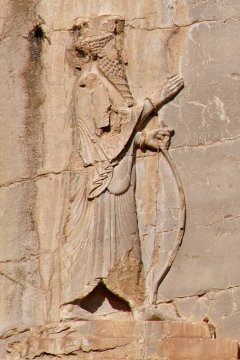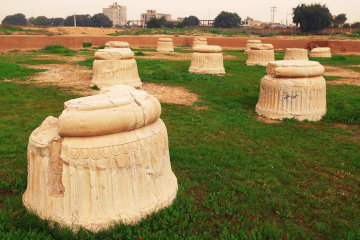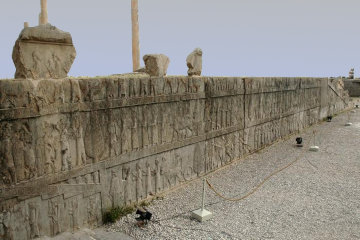Who was Esther?
The Biblical book of Esther is something of a puzzle. In fact, Wikipedia dismisses it with the words, "Because the text lacks any references to known events, some historians believe that the narrative of Esther is fictional." The scribes of Qumran also dismissed it, though in their case the reason was probably that it is the one book in the Bible which does not use the Divine Name - YHWH.
It is true that we have not found any literary or documentary evidence for the existence of either Queen Esther herself or any of the other characters mentioned in the book, such as Haman, Mordechai or the counsellors "Carshena, Shethar, Admatha, Tarshish, Meres, Marsena, and Memucan", or even Queen Vashti herself.

| |
| Xerxes I or "the Great", as depicted by a relief in Persepolis. |
Xerxes' wife, according to the historical sources, was Amestris, a rather unpleasant woman. According to Herodotus, "I have heard that Amestris, the wife of Xerxes, in her old age buried alive seven pairs of Persian youths, sons of illustrious men, as a thank-offering to the god who is supposed to dwell underneath the earth." He also tells the story of how Amestris dealt with Xerxes' mistress Artaytna, a tale which does no credit to either woman but which does demonstrate that Xerxes was in the habit of making extravagant offers to his womenfolk. Esther has him repeatedly assuring her that her request would be granted "up to half my kingdom".
On the other hand, Persian names are severely mangled by both Greek and Hebrew sources; "Ahasuerus" is not readily recognisable as "Xerxes", for example, and "Memucan" in Esther is no more un-Persian than "Oeobazus" in Herodotus. The other names may sound odd, but so do the genuine names obtained from the Behistun Inscription, where the rebels against King Darius are listed as ššina, Nidintu-Bêl, Tritantaechmes, Arakha, Frâda and Skunkha the Sacan.
Unfortunately Wikipedia is not exactly dependable in its treatment of matters pertaining to the Bible. For example, it claims that "In the narrative, King Ahasuerus is drunk at a celebration of the third year of his reign, and orders his queen, Vashti, to appear before him and his guests in the nude to display her beauty."
In fact the text merely states, "To bring Vashti the queen before the king with the crown royal, to shew the people and the princes her beauty: for she was fair to look on." (Esther 1:11) The LXX is equally coy: "To bring in the queen to him, to enthrone her, and crown her with the diadem, and to shew her to the princes, and her beauty to the nations: for she was beautiful." (Incidentally, the LXX gives the queen's name as "Astin", not Vashti, showing how unreliable the transliteration of foreign names could be.)
It is, of course, possible that Xerxes did command that his wife be brought in naked - he was certainly the worse for wear, as the saying is, and drunk men do make stupid commands. On the other hand, Persian women were commonly shut away in harems, and even being exposed to the drunken courtiers with her face showing would have been considered by Vashti to be a disgrace. The point is, however, that the text does not specify "naked" and Wikipedia seems to be allowing a prurient imagination too free a rein.

| |
| The bases of pillars in the royal palace in Susa (Shush or Shushan). |
However the book of Esther does fit into the known events of Xerxes' reign. The book begins with a great assembly and feast in the third year of Xerxes, to which all the satraps and nobles in the kingdom were invited. The question is, when was this "third year"?
Modern histories, including Wikipedia, gives Xerxes' dates as 486 - 465 BC. It is certainly true that Xerxes came to the throne in October 486 BC when his father, Darius I, died. However the Persian custom was for the remainder of that year - and Persian years ran from spring to spring, March/April to March/April - to be counted as part of the last year of the preceding king's reign. Only with New Year's Day did the first year of the new king commence. Thus according to Persian and Jewish reckoning, Xerxes' first year was March/April 485 BC to March/April 484 BC.
It is obvious, therefore, that Xerxes' third year would have been March 483 to March 482 BC. As the feast was held outdoors in the palace gardens and as the hills of Persia are bitterly cold in winter and not much better in spring, it is obvious that the feasting took place in the summer of 483 BC. Wikipedia states "From 483 BC, Xerxes prepared his expedition against Greece." It is entirely likely that Xerxes, as well as ordering the preparations listed in Wikipedia, would also summon the various provincial dignitaries, both to check on their loyalty and to extract from them as many men and as much money as possible for the forthcoming campaign against Greece.
Herodotus appears to refer to this same event by saying, "After Egypt was subdued, Xerxes, being about to take in hand the expedition against Athens, called together an assembly of the noblest Persians to learn their opinions, and to lay before them his own designs." (Histories VII.8) Herodotus states that towards the end of the assembly Xerxes had a dream and sought its interpretation from the Magi. "So when the Magi had thus interpreted the vision, straightway all the Persians who were come together departed to their several governments, where each displayed the greatest zeal, on the faith of the king's offers. For all hoped to obtain for themselves the gifts which had been promised. And so Xerxes gathered together his host, ransacking every corner of the continent." (Histories< VII.19)

| |
| The relief of the tribute bearers in Persepolis. |
Reliefs at Persepolis depict a procession of tribute bearers, who may very well have been the people described by Esther. However at this early period Persepolis was still a building site and in addition, its location in a remote and mountainous region may have rendered it unsuitable for Xerxes' feast.
Could Vashti - or Astin - be Queen Amestris? Whether it is philologically possible to transform one into the other I am not qualified to state. However the fact that Xerxes divorced Vashti while he appears to have remained married to Amestris throughout his reign does argue against the identification. Wikipedia lists Xerxes' children in two groups; those who were his children by Amestris and those "by unknown queens or mistresses". It is therefore possible that although Vashti takes the role of chief queen by entertaining the women of the Persian nobility, she was nonetheless one of these "unknown queens or mistresses". Which, in turn, means that Esther was not Xerxes' sole or even principal queen but merely one of these secondary members of the royal harem.
Another indication that Vashti was not Amestris is the fact that she was in Shushan or Susa. The Persian capital of Persepolis was begun by Darius I and brought to completion by Xerxes. As the official royal residence, that is where we would expect to find the chief wife, with secondary wives in charge of the palaces at Susa, Hamedan and Babylon. (Due to its elevation Hamedan was the summer capital; Persepolis, the ceremonial capital, was used in the spring; Babylon was the winter capital as well as the site of the central bureaucracy; Susa, the former Elamite capital, was a reasonable half-way point between Hamedan and Babylon as far as elevation was concerned.)
If you read the book of Esther quickly, you get the impression that Vashti was divorced today and by tomorrow or the following week Xerxes was starting to feel lonely and set in motion the beauty competition which resulted in Esther coming to his attention. "After these things, when the wrath of king Ahasuerus was appeased, he remembered Vashti, and what she had done, and what was decreed against her." (Esther 2:1)
In actual fact Esther was not formally appointed by the king until the seventh year of his reign, which would be March 479 - March 478 BC. The intervening four years were taken up with the disastrous invasion of Greece: Xerxes led his army out of Sardis in the spring of 480 BC, which implies that it was sent to Sardis in late 481 BC. The Battle of Thermopylae took place in August of 480 BC with the Battle of Salamis around a month later. Xerxes then returned to Persian territory, though he may have remained in Sardis until the final defeat of the Persian army under Mardonius in spring 479 BC at the Battle of Platea.
The suggestion of a beauty contest in which Xerxes was the sole judge (and the method of judging not one of which the Miss World competition could approve) may have been a clever move by the royal courtiers to distract the king from his defeat rather than a way to console him for the loss of a secondary member of his numerous harem.
Haman's plot against the Jews did not take place until the twelfth year of Xerxes, which would be 474/73 BC, a mere nine years before Xerxes was assassinated by Artabanus, the commander of the royal bodyguard. The story in Esther of a palace conspiracy against Xerxes is, therefore, not implausible.
The Persepolis Fortification Archive and the Persepolis Treasury Archive comprise in excess of 25,000 cuneiform tablets or fragments of tablets, but unfortunately they are simply administrative records. A typical one reads, "To Vahush the treasurer speak, Artataxma says: 2 karsha silver, the remaining half of the wage, give as wages to men, accountants at the court, sub-ordinate to Vahush. The wage for the month Açiyadiya(?) of the 19th year. 4 men, each (a gap of 4 missing lines) has been given. The receipt (came) from Bagagiya." They throw an interesting light on the economy and administration of the Persian empire but so far, at least, have not enabled us to add any details to the events of Xerxes' reign.
We have as yet no historical support for the existence of Haman, though his name is very likely a corruption of the attested Persian name "Omanes" or "Imanis". It is not impossible that his name, or that of his successor Mordechai, whose name is probably a corruption of the good Babylonian "Marduka", may eventually turn up in the archives mentioned above, but the work of transcribing and translating the tablets has been going on since they were discovered in the 1930s and is still very far from completion.
The main argument for the historicity of the book of Esther is the festival of Purim, which is still celebrated by the Jews today. It would be odd - if not unique - for a major national festival to appear for no reason at all. Even if we dismiss Esther's feasts and Haman's 75' gallows (or impalement stake), we are still left with some significant deliverance as the origin of Purim - and no very good reason for rejecting the idea that a national crisis during the Persian period was the reason for the celebration.
© Kendall K. Down 2021





